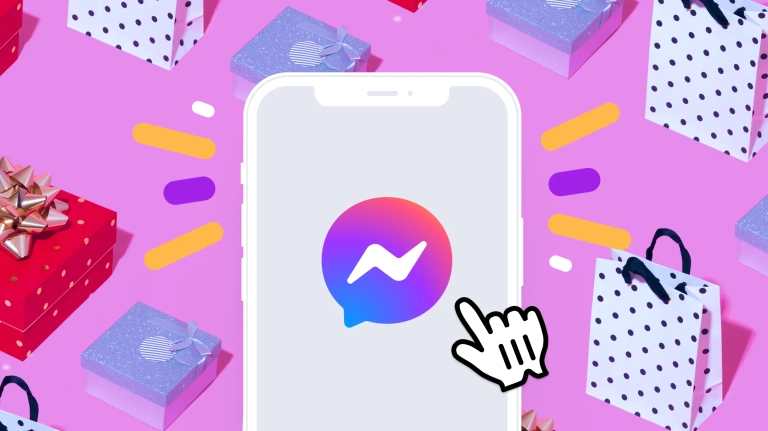
9 reasons your eCommerce business needs a chatbot
Read on to find out what an ecommerce chatbot can do for your online store, and find out how to get started building one.
A great sales assistant can completely transform a shopping experience. Let’s say you walk into a store and get instant, friendly, knowledgable guidance on the products from an employee. You’ll be more likely to find what you’re looking for, and to buy it. But when you click through to most online stores, you’re left to your own devices. � Most online shopping websites have nothing to steer you in the right direction or to answer your questions then and there. And if you, as a customer, can’t get the help you need, you’re less likely to buy.
But here’s an important news flash for ecommerce merchants: It doesn’t have to be this way. You can have an ultra-friendly, always-available, super-knowledgeable sales associate guide prospects down the sales funnel on your site.
First of all: Why Messenger? Because your customers already spend time there. Facebook Messenger has 1.3 billion users, so it makes sense to meet your audience where they are.
Second: Why chatbots? Because there are an estimated 24 million ecommerce sitesout there. Staying competitive means providing a unique, exceptional experience that other retailers don’t. We’re going to give you nine ways a Messenger chatbot can provide this kind of experience for your customers—saving you time and boosting sales in the process. But before we start, you should know one thing:
- Anyone can build a Facebook Messenger chatbot—including you. And you can get started today, for free, with Chatfuel. There’s no previous experience or coding knowledge required, so you can get from ideation to value fast.
Read on to learn how to get started right away!
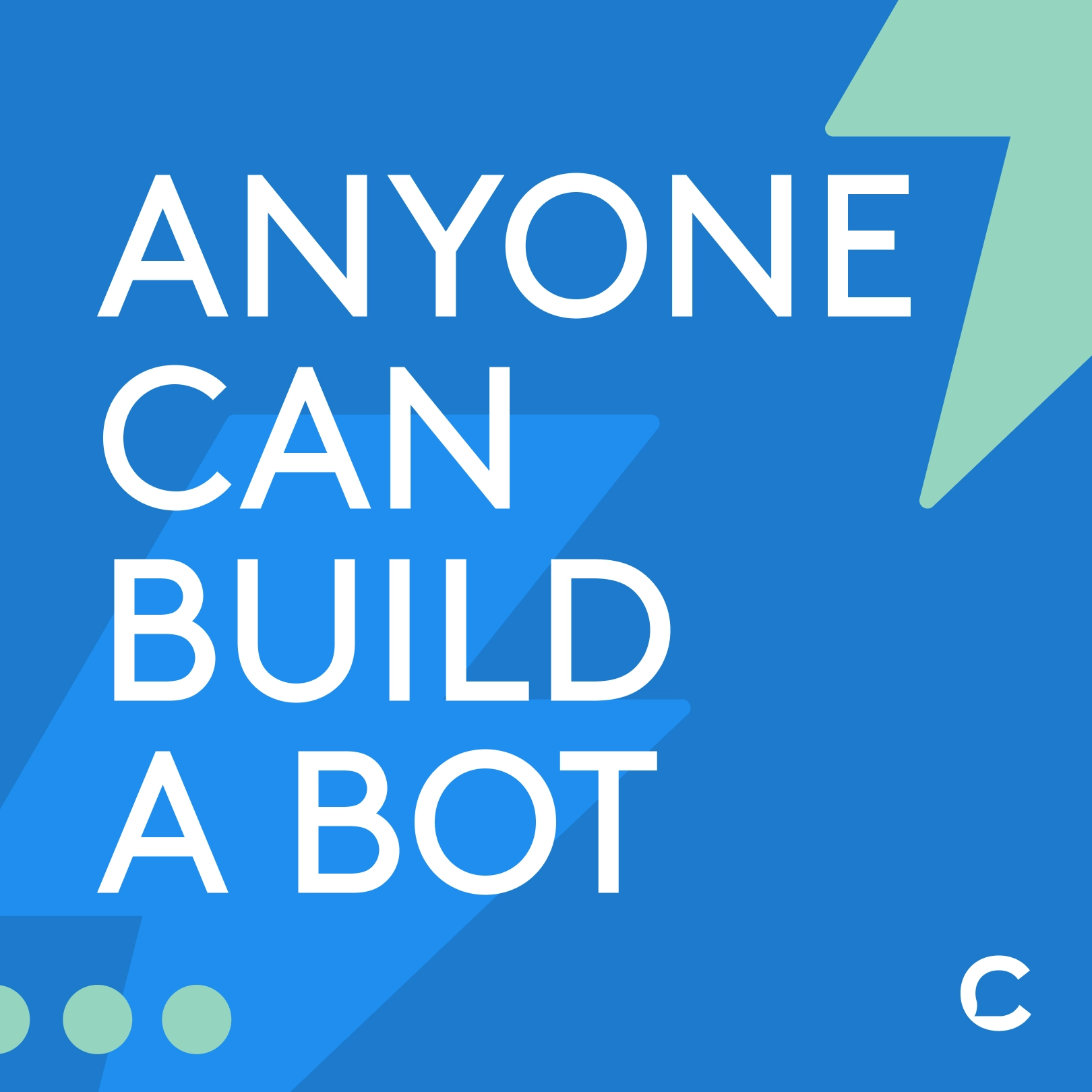
- A chatbot can act as a personal shopper and recommend products
Let’s start with two important stats:
- 80% of consumers are more likely to make a purchase when brands offer personalized experiences (Epislon).
- 49% of customers surveyed said they purchased items they weren’t originally planning to, all because of a personalized recommendation (Segment).
A Facebook Messenger chatbot lets you harness the power of customized product suggestions to boost sales. (And don’t worry; building a simple product recommendation chatbot is easy.) Why does this work so well? First, a chatbot converses in a friendly, back-and-forth style with prospects. It makes shoppers feel comfortable, like they’re chatting with a friend. The result: A low-pressure situation where the prospect is receptive to product recommendations. It’s conversational commerce at its finest!
Second, a chatbot can use its back-and-forth style to quiz users on their needs. It can find out more about their pain points, their preferences, their budget, etc. From there, it can share information, images, and links to purchase for the products that will best fit a particular shopper. To see how the process works, look to:
- Beauty Player 🧴The bot for this skincare startup asks users about their skin type. Is it dry, oily, or combination? Are they concerned about acne, aging, or dryness? Do they have sensitive skin— yes or no? The chatbot can then recommend masks, moisturizers, and other products specifically suited for that prospect’s needs. It also saves the data from the user’s responses as attributes for future retargeting opportunities.
- LEGO 🎁 The famous toy brand launched a Facebook chatbot during the holiday season to help shoppers find the perfect gift for little builders in their life. Their bot asks users about the gift recipient’s age and interests, and the shopper’s budget. It then returns the top LEGO sets that fit the criteria—along with links to buy, of course.
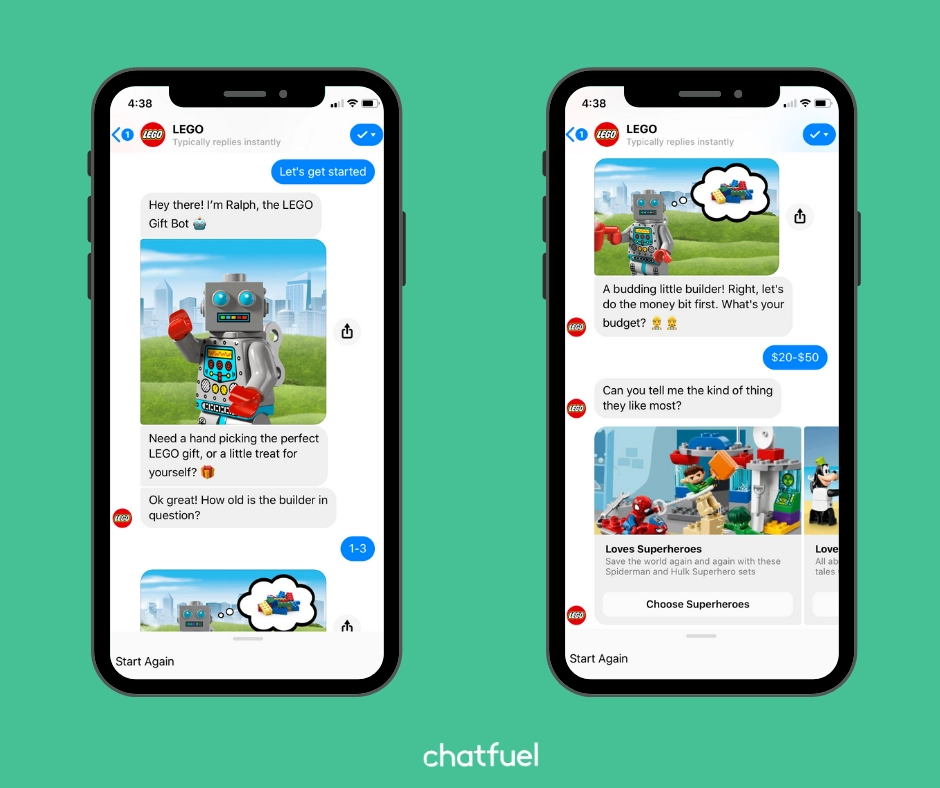
- A chatbot can improve your return on ad spend (ROAS)
So you’ve created dazzling Facebook ads or Instagram ads that get prospects to click. Great! What happens next? In most cases, users land on your online store website and again, are left to their own devices. To increase conversions and your ROAS, add a Facebook chatbot to the mix. You could:
- Embed a Messenger chatbot on your website 💻 Your bot can pop up on your site to offer assistance when users land on a certain page. If the shopper wants help, they can engage with the bot to get product recommendations or to ask questions. If not, they can shop on their own.
- Send users from an ad to your chatbot in Messenger 🤖 Use a click-to-Messenger ad to bring prospects to your chatbot first, before they even visit your website. The bot can prime them for a purchase by answering questions and suggesting items. From there, it can send them to your site to buy.
- Use data your chatbot gathers to improve ad targeting 🎯 As soon as a user engages with a chatbot, the bot has access to their basic Facebook profile data. And through quizzes and questions, it can gather more data and save it as attributes. You can then create Lookalike audiences to target people similar to your most valuable customers, or custom audiences for retargeting ads. Use Segment Sync in Chatfuel to send this data to Ads Manager in one click. ⬇️
To see how effectively a bot can improve ROAS, check out the case study for 3D Mats. 🚗 The bot for this car-accessories company takes users through a simple product-recommendation flow. It reduced repetitive customer inquiries by 70%, for starters. Even better: They achieved a 999% return on ad spend with retargeting using data from their bot!
- A chatbot can provide instant customer service, 24/7
Even if you have a stellar customer service team, they need to sleep! Most brands can’t afford to have instant, live-chat support from human reps 24/7. A Facebook chatbot, however, can be instantly available around the clock. Bots aren’t meant to replace human agents. But when it comes to answering FAQs, they’re a perfect solution. (In fact, a well-designed chatbot can answer up to 80% of routine inquiries.) You can even build an AI chatbot with Chatfuel, which will be able to respond to a wider range of questions using artificial intelligence.
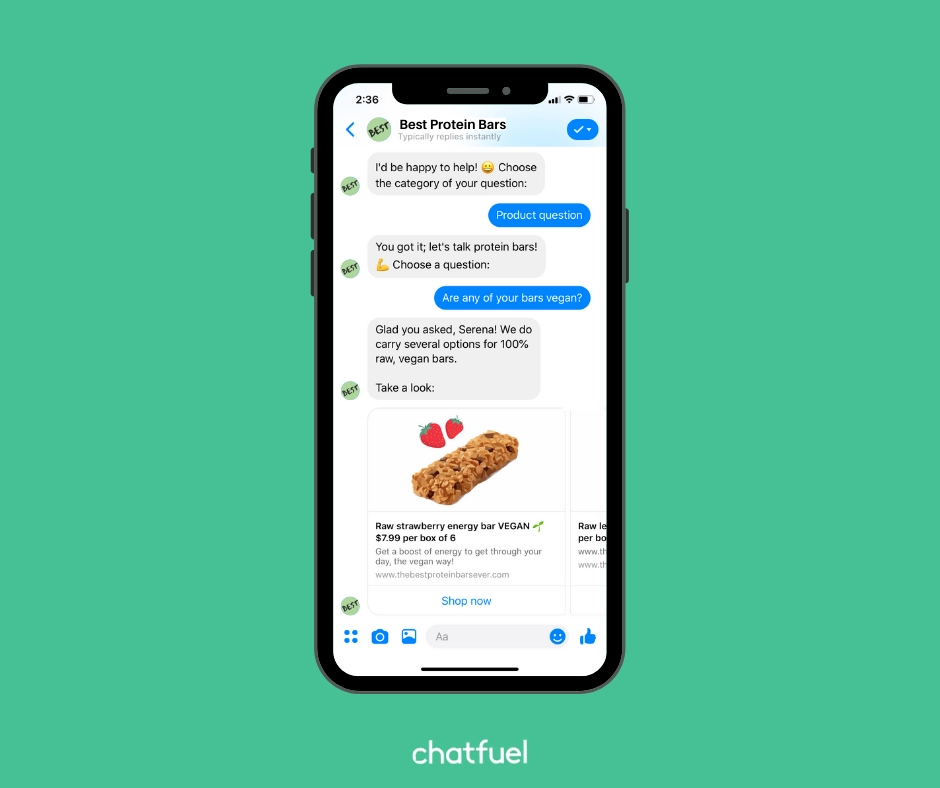
Let’s say a shopper has a question about a product, shipping times, etc. They can’t find the answer on your ecommerce site, and there’s no live agent available to chat. They may well choose to shop elsewhere. So a chatbot that can answer their question immediately could be the difference between a lost sale and a new, satisfied customer.
Plus, having a chatbot handle repetitive questions saves you and your team time. Just look at the case of ecommerce merchant DECEN Muebles, a baby furniture brand. Their chatbot now handles a whopping 98% of customer inquiries, leaving their team time to deal with more complex tasks. (The cherry on top: 80% of the brand’s total sales now come from the bot, too! It’s a perfect win-win.)
- A chatbot can recover up to 7x more abandoned-cart revenue for your ecommerce store
Even if you’ve done everything right, shoppers will still leave without purchasing sometimes. The average abandoned cart rate is over 70%, in fact. Of course, you should try to keep this from happening by providing excellent pre-purchase experiences. But abandonment is an inevitable part of running an ecommerce business—which is why you should have a cart-reminders strategy in place also.
No surprises here: Chatbots can send cart reminders too. In fact, these messages are generally more effective coming from a chatbot than from email or other sources. They’re up to 7x more effective, in our experience. Why? One main reason is that Messenger boasts 80% open rates and 35% click-through rates on average. (For comparison, email’s are 20% and 2%, respectively.) Think about it: It’s not uncommon to have an email inbox with unread messages in the thousands. But how many people let text or instant messages go unread for long? 90% of mobile users open texts within three minutes of receipt, and Messenger notifications are no different.
Chatbot cart reminders work similarly to any other type of cart reminder. (They’re easy to set up, too.) The user just needs to opt in to be contacted on your website, and their abandonment will trigger a notification. The difference is simply that when you send the notifications via Messenger chatbot, shoppers are more likely to open and click them! They get the product they want in the end, and you get more conversions.
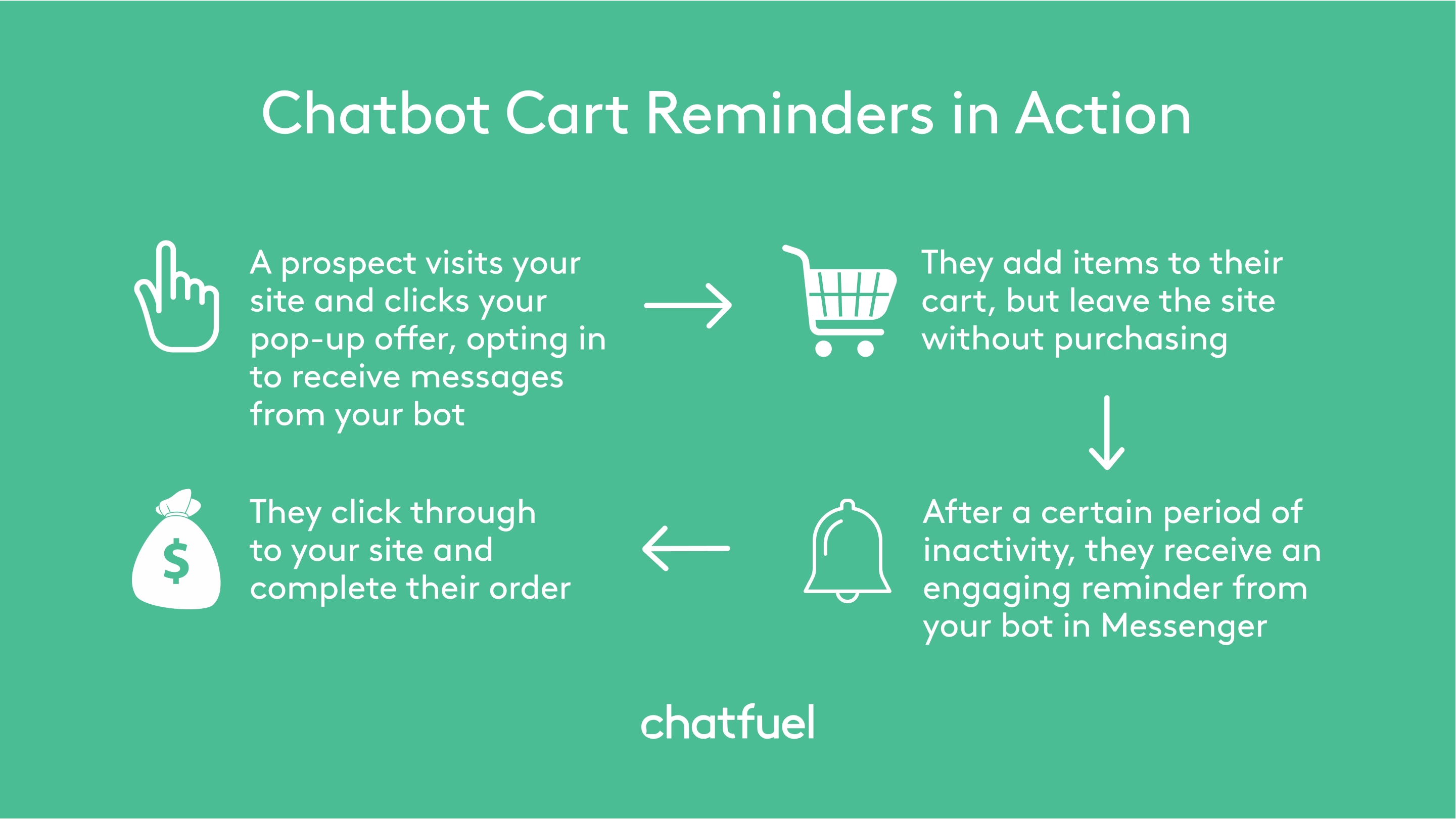
- A chatbot can help you build a multichannel marketing strategy
Two more important facts for you:
- According to a Google study, omnichannel shoppers have a 30% higher lifetime value (LTV) than those who shop on just one channel.
- According to an Aspect Software survey, brands with a strong omnichannel presence enjoy 90% greater customer retention year over year.
A chatbot is a powerful tool—but like any other, it’ll have the greatest impact when used along with others in your arsenal.
Messenger bots can easily gather contact information (and consent) from users so you can reach out to them on other channels. Most users have their phone number and/or email linked to their Facebook account already. That means it takes just one tap for them to share that information with your bot. The chatbot can then store it in Chatfuel’s People tab for your future multichannel marketing purposes.
You can see how the Save User Phone Number plugin works below. The Save User Email plugin works the same way. Note that you can also integrate Chatfuel with SMS services like Twilio, and even enable phone number verification in the bot for higher deliverability.
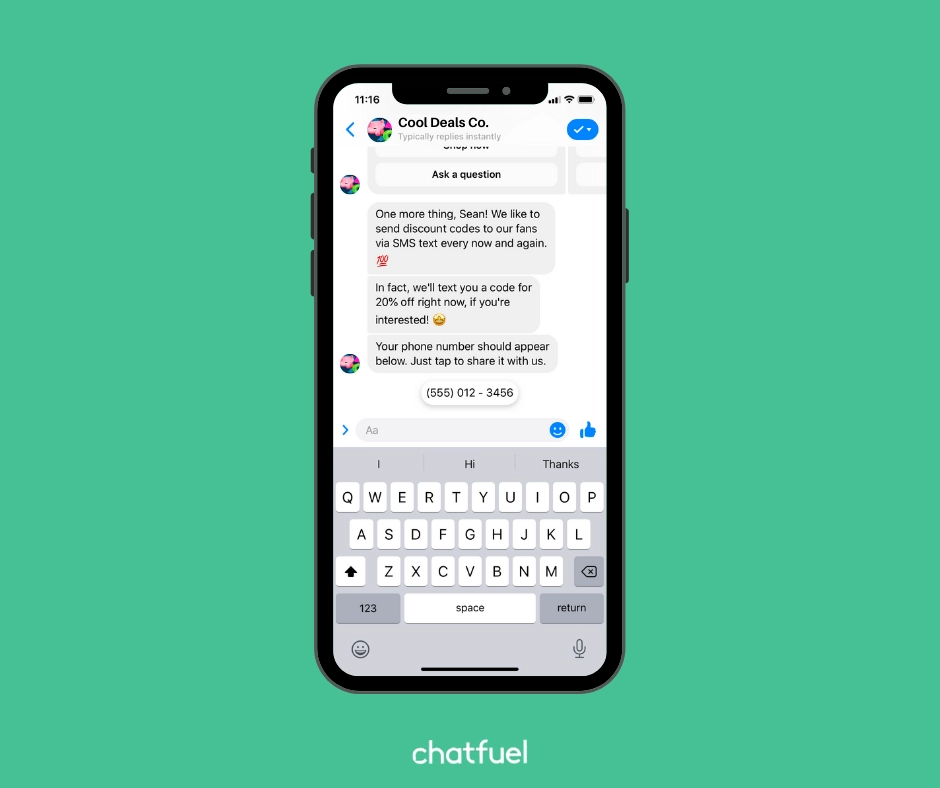
- A chatbot can automatically engage prospects on your Facebook Page
Think of a Messenger chatbot like a net. It can catch prospects who may have otherwise been lost and drive them towards a conversion. For example, a bot can appear on your website to answer questions or guide uncertain users to the right product, as we discussed earlier. And it can work a similar kind of magic with users who comment on your Facebook page posts.

With Chatfuel’s Comments Autoreply feature, you can set your bot to automatically reply to commenters. You can have your chatbot respond to all comments on a post, or only those containing a keyword. (You can have it post a public reply too.) It’s a great way to make sure none of the prospects engaging with your posts fall through the cracks. With your bot reaching out to them individually, each one will be that much more likely to convert. Plus, it’ll save you time, since you don’t have to reply to each comment yourself. Common use cases for this feature include:
- Contests and giveaways 🎊 It’s especially helpful when there are too many entrants for you to respond to manually.
- New product announcements 📣 You can prepare your bot to answer common questions you know you’ll be asked over and over, like Do you ship to [country]? or Will this come in [size]? , etc.
- A chatbot can reengage past customers later to encourage repeat business
A magical thing happens the first time a user responds to a chatbot: They become “reachable.” That means that, within Facebook’s 24-hour standard messaging window, your bot can contact them with personalized promotional content. You have a full day to start building a relationship with the user—to encourage a conversion, and even start cultivating long-term loyalty.
If the conversation slows or stops within that window and you want to reengage the user, you can use a chatbot sequence. It’s essentially a series of messages sent at specific intervals over time, like an email drip campaign. If you get the prospect to respond to any of these, you can reopen the 24-hour window again.
But naturally, the conversation will end at some point, and the contact window will close. When that happens, you can reach out to users again for free with a One-Time Notification (OTN) if and only if the message fits one of Facebook’s approved use cases. Otherwise, use a sponsored message. 💌 (Note that bots affected by new EU privacy laws won’t be able to send OTNs or sponsored messages after December 16, 2020.) They appear as regular messages to the user, but you pay to send them outside the standard contact window. Sponsored messages are a type of Facebook ad that are useful for notifying prospects or past customers of things like:
- A new product line 👗
- An upcoming sale 💸
- A giveaway or limited-time bonus 🎁
If your sponsored message is enticing enough, the user will respond and reopen that 24-hour window. Your bot can then drive the user toward a purchase, building you a healthy return on ad spend.
- A chatbot can boost retention and loyalty with post-purchase experiences
You may have finally won that conversion, but the customer journey isn’t over yet! A helpful, memorable post-purchase experience from an online seller is crucial. It can help boost retention, brand reputation, and lifetime value (LTV). And of course, a chatbot can help provide this kind of experience.
One of the most important post-purchase experiences is the shipping updates. usersopt in to receive these notifications from your store on Facebook Messenger. Receiving them there instead of via email is unique. It’ll help you stand out in the customer’s mind when they go to shop for a similar product in the future. Plus, due to the higher open rates, users are more likely to view and even engage with these messages.
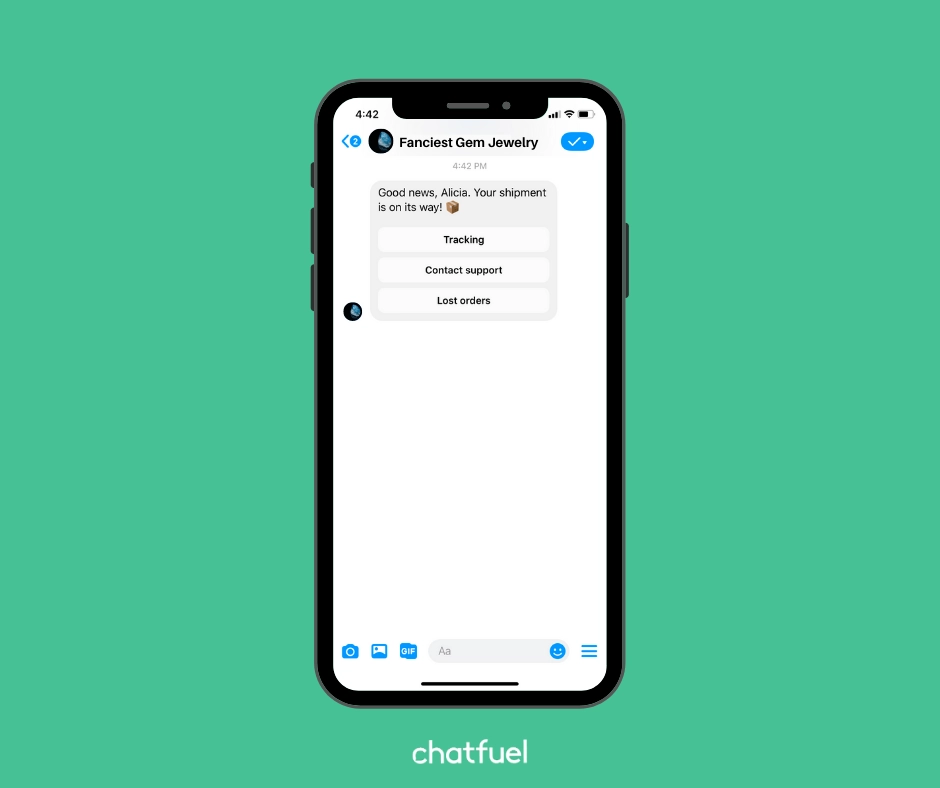
You can use your bot to send other types of content in the 24 hours after the customer has purchased, too. For instance:
- If the product they bought requires setup or instructions, you could send a manual or a helpful video.
- If there’s a complementary product they might find useful, your bot could auto-upsell it. Your chatbot could even include a coupon code for their next purchase.
- If you want to gauge customer satisfaction with the shopping experience, you could request a rating or send survey questions via bot.
- An ecommerce chatbot is easy to build with our free templates
Remember what we said earlier: You don’t need to be a developer or have previous experience to build a chatbot for your ecommerce company. Chatfuel is a no-code platform that makes it easy to design a chatbot flow to accomplish all eight ecommerce goals above. We offer ready-made chatbot templates to help you get started. You’ll be able to preview it, or load it into your workspace and start customizing it right away.
Your quick-start guide to building an ecommerce chatbot
Ready to build a chatbot for your ecommerce store? Here’s what to do:
- Sign up for a free Chatfuel account.
- Connect your Facebook page to Chatfuel.
- Load one of the pre-designed ecommerce templates we mentioned above. Customize the information for your business, test, and launch!
